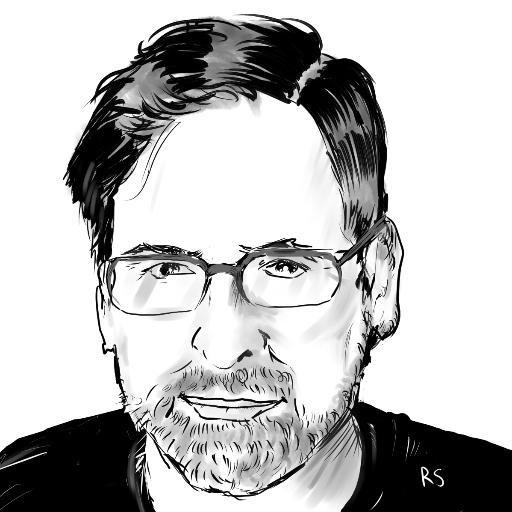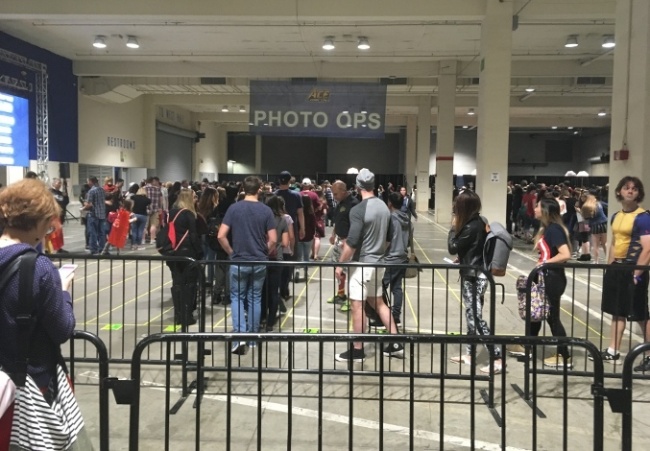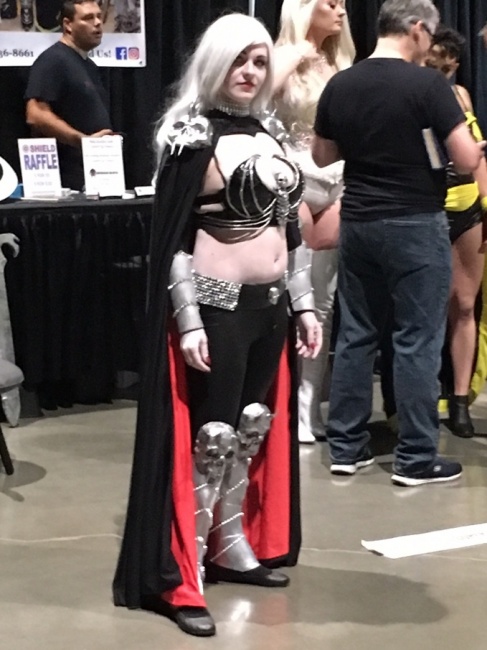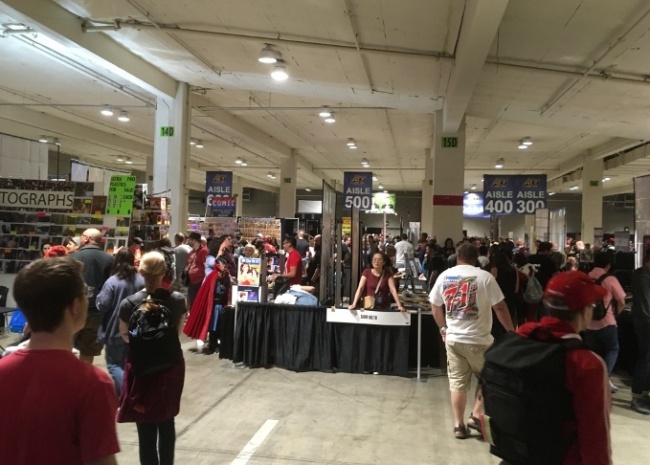I have seen the future of fan conventions and it is dark.
That’s not a metaphor. Walking into the Ace Comic Con in Seattle’s cavernous Century Link Exhibition Center, the first thing that hits you is the lack of lighting, like a movie theatre before the previews come on. Between the low lights, the black curtains surrounding the giant main stage, the echelons of gray bleachers, and the darkened corridor between the first hall and the exhibitor’s area, the environment felt post-industrial if not post-apocalyptic.
That didn’t deter 10-12,000 fans per day from spending three of the longest days of the year in the presence of Hollywood star power instead of rare Seattle sunshine. Ace boasted a top-heavy lineup of celebrities from Marvel’s Avengers. Chris Evans and Chris Hemsworth, the announced headliners, both couldn’t make it, but Tom Hiddleston, Tom Holland, Elizabeth Olsen, Paul Bettany and Haley Atwell along with last-minute subs Sebastian Stan and Anthony Mackie, plus the Flash’s Grant Gustin, Riverdale’s Camila Mendes, and assorted other geek culture favorites were on hand.
Celebrities were featured on the main stage in programs open to all attendees throughout the three days, but the real business of the show was done behind the scenes, with VIP-only sessions, autographs and photo-ops available to fans shelling out hundreds of dollars on top of general admission. A package including a photo with one of the headliners cost between $200 and $550. A group photo with all the present Avengers could set you back $700.
In the exhibit area of this self-proclaimed Comic Con, a cramped but slightly better-lit appendage to the main stage area, maybe a half dozen of the 100-odd dealers were selling comics. The artists were spread out in different areas of the floor, interspersed with vendors of other merchandise and collectibles.
A well-oiled machine. If it sounds like I am painting a grim picture, let me hasten to add that I spoke to more than a dozen ordinary fan attendees and the feedback was generally positive. There was a slight hiccup with VIP admission on Friday night that was quickly corrected, and some of the venue signage was confusing. There were some delays with photo ops, leading to charges of "disorganization," but it fell far short of the total chaos that some shows descend into. The panels I saw were entertaining, particularly the one featuring Olsen and Bettany, moderated by Kevin Smith, although apparently the audience questions during the Civil War panel with Holland, Mackie and Stan went off the rails. Given that no show will please everyone, this seemed well within operating parameters. People were happy, families were having fun, the celebs delivered.
And the exhibitors? Everyone I spoke to was making money on Saturday afternoon. The comic dealers in particular came in with low expectations and some reported doing better sales than they’d done at Emerald City Comic Con, a show 3-4x bigger. Several vendors even complimented the load-in and set up process; how many times do you hear that from veteran con exhibitors?
Merchandise moved briskly, the artists were busy, cosplayers and C-list celebrities had lines in front of their booths, and fans had big smiles departing from the banks of color printers that were spitting out their hard-won celebrity photos.
According to organizer Gareb Shamus, this third Ace Universe event was a near sellout, with the venue at capacity on Saturday and only a few unsold tickets for Sunday. It may not have been pretty, but it seemed to be effective.
Give the people what they want. Say what you will about Ace CEO Shamus and his brother, CMO Stephen Shamus, but they have an uncanny feel for what a certain kind of fan wants, and they know how to cater to them. In the 1990s, they recognized how the collectors’ instinct within the comics community could be stoked by promises of financial rewards and bragging rights by being the first to get in on "hot" books. In the late 90s, they saw an opportunity to scale comic-oriented events by bringing in wrestlers, sports stars, non-geek entertainment figures and anyone with appeal to a specific fandom, anticipating our current era of pop culture conventions.
With Ace Universe, they are showing what a fan-oriented event can become when it abandons any pretense of putting comics at the center, and goes all-in on the celebrity and entertainment angle.
Gareb Shamus describes Ace as a "superhero show" aimed primarily at fans who come to superheroes through movies, TV, games and other media. Comics are present, but not privileged. There are no panels specifically on the medium or its history and nothing geared toward publishing. There’s no Artist Alley per se; only a couple of artists mixed in with the cosplayers, crafters and Instagram favorites. When art appears on the program, it is a drawing demonstration by Korean phenom Kim Jung-Gi or a "how to draw Spidey" workshop for kids: that is, part of the spectacle.
The Non-Comics Comic Con. Needless to say, this approach does not suit everyone. I never truly understood the meaning of the term "made my skin crawl" until I witnessed the reaction of a group of comics scholars and art aficionados who were touring the floor as part of a business presentation. Ace was about as close to their vision of hell as can be imagined.
One could, as these people did, uncharitably describe the programming, spartan decor and logistics of the show as ballast for Ace’s real mission, the traffic in high-priced celebrity photos. And it’s true: the Shamus brother have built a very efficient system for separating fans from their money. The show’s budget was up on the marquee, nowhere else.
But just as clearly, they understand what some fans of superhero media want. It’s not lectures on the importance and sanctity of comic books. Even for big bucks, it’s not a fancy, luxury event in a well-lit space. It’s the thirty second brush with fame, the trophy shot, and the experience. Take my money, give me a selfie with a legit A-list movie star, don’t waste my time.
Other events may end up at this transactional level but they don’t lean into it quite this hard. Ace owns it all the way. And it makes business sense. When you don’t feel obliged to follow the 40-plus year-old template of comic conventions, other issues solve themselves.
You don’t need a facility with a giant exhibitor floor or a lot of little meeting rooms if the center of the event is a single track of celebrity-oriented programming in one theatre-style environment. You don’t need as much security or line management either, since everyone is in "Hall H" by default and there’s enough seating for every attendee to catch whatever is on the main stage. When you make most of your money selling $500 photo-ops and VIP packages, you don’t need to sell tables to hundreds of dealers. Fewer dealers means more customers per dealer and no traffic jams at the loading dock.
The Shamus brothers figured all this out and designed their event accordingly. When Gareb Shamus says he’s reinventing the convention experience, this is what he means.
The only real question is why the show is branded "Ace Comic Con," as opposed to any of the myriad other designations that more accurately represent its focus? The only conceivable advantage is to create some kind of subconscious association with San Diego or New York Comic Cons, under the theory that the term has become so generic. On the other hand, no one I spoke to at the show harbored any confusion about who was running the event, to the extent they even cared.
Different strokes. As you can guess, this was not a show that appealed to me personally. If Ace Comic Con were the only type of fan experience available, I think I’d take up falconry, basket weaving or some other pastime. But it’s not the only kind of con – not by a long shot.
Just here in my little corner of the world, there’s the staunchly independent alt-press Short Run in late fall, Pax West for the gamers on Labor Day weekend, the manga/anime SakuraCon over Easter, fem-positive GeekGirl Con in October, Emerald City in March – all beloved by their specific audiences and ridiculously well-attended – plus a dozen regional shows throughout the year within a few hours’ drive. If you have a problem with Ace, skip it and go to something else. But if you need to meet an Avenger and have a few hundred bucks burning a hole in your pocket, they’ve got you covered.
More to the point, I’m not the only kind of fan and don’t need every event designed around what I like. The millions of people who consume superhero media and don’t give a damn about comics clearly represent the ascendant majority of fandom. We snobby old school fans finally won the argument that everyone should love what we love and be as obsessive about these stories as we are. This is what our victory looks like.
Now please, someone turn on the lights.
Click on the Gallery below for full-sized images from Ace Comic Con. Photos by E. Verstegen.
For more on the Ace Universe launch last fall, see "ICv2 Interview: Gareb Shamus of Ace Universe." – ed.
The opinions expressed in this column are solely those of the writer, and do not necessarily reflect the views of the editorial staff of ICv2.com.
Rob Salkowitz (@robsalk) is the author of Comic-Con and the Business of Pop Culture.

Column by Rob Salkowitz
Posted by Rob Salkowitz on June 25, 2018 @ 2:08 pm CT







 View Gallery: 12 Images
View Gallery: 12 Images